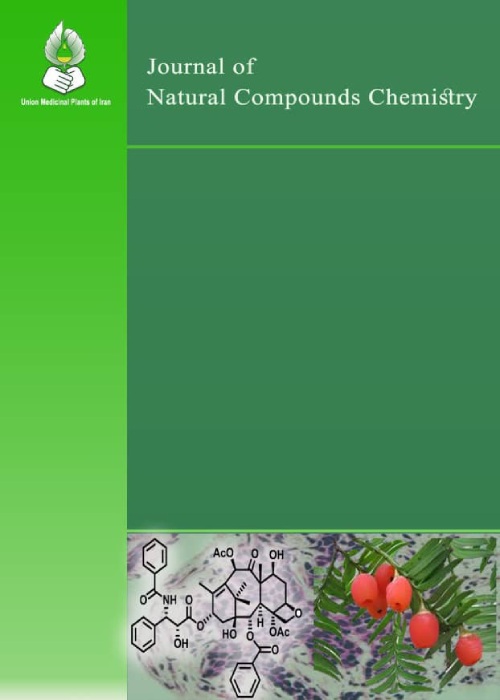فهرست مطالب

Journal of Natural Compounds Chemistry
Volume:2 Issue: 1, Oct 2023
- تاریخ انتشار: 1402/07/09
- تعداد عناوین: 5
-
Pages 45-53
Extensive biological activities associated with xanthenes, both synthetic and naturally occurring, ensure that the synthesis of these compounds remains a topic of current interest. In this research, an efficient methods for the synthesis of some bulky xanthenediones was developed by the reaction of dimedone or 1,3-cyclohexadione with aledydes or bisaldehydes in the presence of polyvinylpolypyrrolidone supported p-toluene sulfonic acid (PVPP-p-TSA) as a new polymeric catalyst in ethanol at room temperature. Forthermore, a convenient method for the synthesis of (arylmethylene)bis(naphthalene-2-yl-sulfane) derivatives by polyvinylpolypyrrolidone supported p-toluene sulfonic acid (PVPP-p-TSA) is described. The reaction proceeded via condensation of aldehydes with 2-thionaphthol in the presence of PVPP-p-TSA in ethanol at reflux conditions. All synthesized compounds were identified by FT-IR, 1H-NMR and 13C-NMR spectroscopic techniques. Polyvinylpolypyrrolidone supported p-toluene sulfonic acid (PVPP-p-TSA) was characterized via Fourier transform infrared spectroscopy (FT-IR), thermal gravimetric analysis (TGA), scanning electron microscopy (SEM) and energy dispersive X-ray spectroscopy (EDX). Clean methodologies, simple preparation of the catalyst, high yields, environment-friendly and reusable catalyst are some advantages of this work.
Keywords: Polyvinylpolypyrrolidone, P-Toluene sulfonic acid, Xanthenediones, (arylmethylene)bis(naphthalene-2-yl-sulfane) -
Pages 54-59
The inhibition effect of two dimeric coumarins was validated against main protease of severe acute respiratory syndrome -coronavirus 2 (SARS-COV2) via Molecular docking approach. The phytochemicals 5, 5′-bi (6, 7- dihydroxycoumarin) and 6,6′,7,7′- tetrahydroxy-5,8′- bicoumarin from Viola philippica are inhibitor activity of NS3/4A protease of hepatitis C virus (HCV). The inhibitory for SARS-COV2 main protease estimated by evaluation of binding energy and conformation. The value of predicted binding energy equal -8.07 for 5, 5′-bi (6, 7- dihydroxycoumarin) conform its ability for SARS-COV2 main protease inhibition. This invitro analysis identified the activity of anti-HCV natural inhibitor for SARS-COV2 therapy.
Keywords: SARS-COV2, Molecular Docking, protease inhibitor, Coumarin, Viola philippica -
Pages 60-67Background
In the Rosaceae family, Rosa damascene Mill. is an important medicinal plant. Studies reported its antioxidant, cardioprotective, and neuroprotective effects that may be related to the anti-hypoxic activity. So, we investigated the anti-hypoxic effects of R. damascenaare in this study to evaluate the possible mechanism of plant effectiveness in cardiovascular and neurological disease.
MethodsThe R. damascenaare flowers were extracted with methanol by maceration method and anti-hypoxic activities were evaluated in haemic, asphyctic, and circulatory models.
ResultsIn asphyctic hypoxia, extract at 250 mg/kg increased the survival time to 21.53±1.21 minutes, which was significantly lower (P<0.0001) than phenytoin (29.60±1.34 minutes). In haemic hypoxia, extract effects were similar to propranolol (P>0.05) at 125, and 250 mg/kg (15.85±0.69 and 16.19±1.71 vs. 16.44±1.39 minutes, P>0.05). In circulatory hypoxia, extract significantly increased the survival time at 250 mg/kg compared to the negative control (13.64±1.51 vs. 9.79±0.56 minutes, P<0.01) but its effect was weaker than propranolol (16.44±1.39 minutes).
ConclusionR. damascenaare show potent anti-hypoxic activity in the haemic model. Its effects were significant in higher doses in asphyctic and circulatory models.
Keywords: Cardiovascular diseases, Reactive oxygen species, Asphyxia, ischemia, Stroke -
Pages 68-74
Phytotherapy is one of the most ancient methods in traditional treatment. Medicinal plants are very important in terms of hygienic and public health, either treatment or prevention of diseases. The genus of citrus belongs to the family of Rutaceae, which grows in the regions of temperate and warm and the shoots of Citrus have a drastic odor. Some of them have edible fruit, the others are for treatment or essence extraction. In this research, the organs of Citrus aurantium L. contains blossom, leaf, and external rind of immature fruit in Mazandaran and Golestan provinces were collected and tried to investigation of specific compositions and medicinal characters. The extracted essences of Citrus aurantium L. due to different compositions like varied monoterpenes and sesquiterpenes have the effects of expectorant, diuretic, decreasing blood pressure and bacterial and fungal infections, to settle inflammation, polyneuritis, gastroenteritis and the effect of antitumor against Leucémie p383, controlling effect of cell growth of extract in cancers K562, L 1210 and else. Results of this study shown that, alkaloid compounds in the fruit peel of C. aurantium with an average of (0.91 - 1.590) in Amol and Gorgan city, respectively, was higher than that of flowers and leaves, which was higher in Gorgan than Amol. The most amount of total flavonoids in the orange flower of Amol city with an average of 90.92 mg and the most amount of total phenol in the orange flower of Gorgan with an average of 22.7 mg was observed.
Keywords: Citrus aurantium L. pharmaceutical effects, Antioxidant effects, Alkaloids -
Pages 75-81
The most of medicinal plant seeds contain of polysaccharides with specific functional properties and used as a hydrocolloids source. Mucilages are polysaccharides with long chain molecules. In order to study the effect of different temperatures on the amount of mucilage and dry matter extraction (DME) in two medicinal plants of Plantago psyllium L. and Plantag omajor L. an experiment was carried out in a randomized complete block design with three replications at five temperature levels: 30, 40, 50, 60 and 70 °C. The results showed that in P. psyllium, the highest amount of mucilage (24.55 ml) and DME were obtained from 40 °C treatments and the lowest amounts of mucilage and DME were recorded at 70 °C. It found that when the temperature reached from 60 to 70 °C, the amount of DME in P. psyllium was decreased significantly, so that at 70 °C the amount of DME decreased was 56% in compared of 60 °C. In P. major: The highest amount of mucilage (28.6 ml) was obtained at 40°C and the lowest of it was observed at 70 °C. The highest (0.897 gram) and the lowest (0.523 gram) amount of DME was obtained at 30 °C and 70 °C in P. major, respectively. In general, the amount of extracted mucilage seems to depend on the water-to-grain ratio, and as the ratio decreases, the amount of mucilage decreases at high temperatures.
Keywords: dry matter, extraction, water to grain ratio

